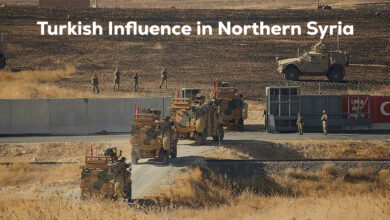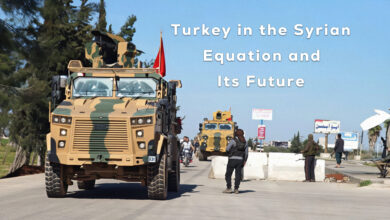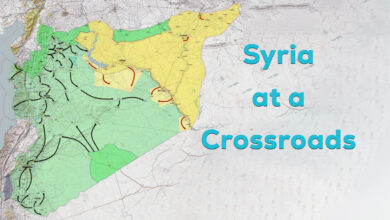Potential American-Russian consensus on Syria

The US and Russia are considered the main players in the Syrian crisis, and they have the keys of solution, but each of them has specific goals and strategies. The US confirms that its presence in Syria, in partnership with the Syrian Democratic Forces (SDF), is to end terrorist organizations and prevent ISIS from resurrection, in addition to protecting its strategic interests in the Middle East. While Russia sees Syria as an economic and military center to protect its national security, “the project to transport gas to Europe” and its presence in the warm waters, “the Mediterranean, the meeting point of the three continents” to be part of global events and its return as a second pole. However, the deterioration of the Syrian crisis as a result of the intervention of the regional powers – Turkey and Iran – created differences between the two states, especially with Turkey’s purchase of the Russian S-400 system. These differences between two nuclear states in a small geographical area is a very dangerous matter that will affect international peace and security. Therefore, and in order not to collide, the Euphrates River was considered the boundary between the two forces in Syria.
Turkey, which is a member of NATO, an ally of the United States, has taken a different path from the American policy in Syria. In addition to the Russian S400 deal and the Astana and Sochi conferences, the Turkish invasion of the Tel Abyad and Sere Kaniye (Ras al-Ain) areas made the US to decide to withdraw from the border area so that no military collision with Turkey would take place, which led to a Russian incursion into the east of the Euphrates. This policy that Erdogan pursued far from the US made the latter, during Biden’s period, to follow a policy of ignoring Turkey and making it alone in Syria, and allowing Russia to carry out limited military operations on Idlib so that Turkey would be alone in the face of Russian pressure, in order to force it to return to the right track as an ally of the US. Biden might aim to unify the areas outside the control of the Syrian regime and the formation of a new opposition body, so we do not see any position from the US towards the Russian bombing of the Idlib areas, unlike the past periods that were against any Russian military operation in Idlib. Also, the US has fears of the return of the terrorist organizations, that are deploying in the areas of the Turkish occupation, to Idlib, especially since Taliban took control of Afghanistan, where Biden stressed that “the danger of terrorism in Afghanistan has decreased compared to what it was before the attacks of September 11, 2001.” He also stressed the existence of more serious threats to the United States in the world and that al-Qaeda and ISIS have spread, and there is a much greater danger to the US that comes from Syria and from East Africa. Therefore, Turkey is working to integrate its mercenaries into a new formation to expel its terrorist organizations from the danger of the American bombing and not including other factions in the terrorist lists. This is in addition to the Iranian militias in Syria and the Chinese threat.
As for the Russian-Turkish relations, despite Russia’s success in creating a rift in the Turkish-American relations, and the Turkish-Russian rapprochement during the past period, Russia realizes the impossibility of Turkey to leave the western umbrella. So, Russia was able, through Turkey, to end the armed factions inside Syria and confine them to Idlib and northern Syria, nor Russia stops at this point, but rather aims at controlling the entire northern Syria, especially the M4 Highway. Putin Erdogan’s agreement on “de-escalation zone” did not succeed, as the terrorist organizations still pose a threat to Russia. On 11/9, al-Qaeda published a speech of its leader, Ayman al-Zawahiri, during which he spoke about several political and military developments, the noteworthy among them was that of Syria, as he praised the attack that targeted a position of the Russian forces in the Tel al-Samen area in the countryside of Raqqa, early this year. The attack was claimed at the time by the Guardians of Religion Organization, which is linked to al-Qaeda. Al-Zawahiri described the Tel al-Samen incident as a “successful operation,” adding that “exhausting the enemy is the duty of the stage,” speaking of “exhaustion operations behind the lines.” This is in addition to terrorist organizations such as Hayat Tahrir al-Sham (HTS-al-Nusra Front) and the mercenary factions affiliated with Turkey. Also, the Russian-Turkish relations have recently been going through a phase of distrust, the Turkish drone deal for Ukraine, the desire of Poland and Georgia to buy these drones, Turkey’s desire to establish military bases in Azerbaijan, the Turkish presence in Afghanistan and its impact on neighboring countries – Turkish-speaking countries – along with terrorist organizations in Idlib, and Erdogan’s statement that Turkey does not recognize the affiliation of the Crimea to Russia, where in the past, it did not support Western sanctions against Moscow after the annexation of Crimea.
Russia is trying to end these organizations and restore northern Syria. In the first stage, it may aim to control the M4 Highway between the cities of Saraqib and Jisr al-Shughur, and the second stage may be Idlib, Afrin and the Euphrates Shield areas. Russia cannot launch a major military operation unless it takes the green light from the US. Also, the Caesar Act constitutes a major obstacle to Russian investments in Syria and prevents it from reaping the fruits of its military intervention.
Within this context, there are points of convergence between the US and Russia, represented in the following: 1- The threat of terrorist organizations. 2- The US fears of Iranian expansion. 3- Russia’s fears of Turkish military expansion in Eastern Europe (the drone deal) and Biden’s dissatisfaction with Turkey’s policy in Syria. 4- Preserving Israeli national security. 5- Caesar’s Act. Therefore, it is very likely that an American-Russian rapprochement will occur in Syria and reach a unified formula based on a federal Syria consisting of two areas, one under Russian protection that includes the regime’s areas, and the other merging the Turkish-occupied areas with that of the Autonomous Administration, where the Autonomous Administration has proven its neutral position as the “third line” of the conflicting parties, in addition to that it does not pose any threat to any of the global and regional powers and its success in managing the region and in fighting terrorist organizations. This area will be under American protection. In return, Caesar Act on Syria will be lifted, and Russia will be allowed to control the M4 Highway, start fighting terrorist organizations in Syria and expelling the Iranian militias. As a goodwill gesture, the US started to ease sanctions on the regime by transferring gas from Egypt to Lebanon via Syria and starting the restoration of relations between the regime and Jordan, through opening the Nasib border crossing. Tis corresponded to the failure of the Sochi summit between Putin and Erdogan, and Biden’s refusal to receive Erdogan during the UN General Assembly. Therefore, any settlement of the Syrian crisis in the future will be American, Russian, and Israeli, but Turkey will not be a party to it as long as it stays away from the US and pursues a different policy.




